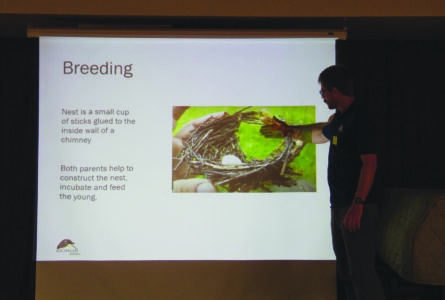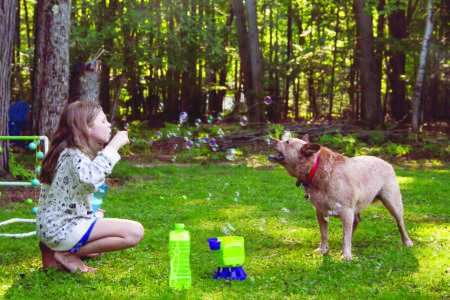Residents join effort to help chimney swifts

RR Branstrom Daily Press Chad Machinski, conservation manager for Michigan Audubon, shows an example of a chimney swift nest at a recent presentation in Escanaba.
ESCANABA — A unique little bird has recently been classified as an “orange alert tipping point species,” meaning its populations have been in rapid decline. They are known to Escanaba and other places in Michigan, but scientists need help tracking them.
The bird in question is the chimney swift, so named for its tendency to roost in chimneys and smokestacks.
These animals are small — weighing about one ounce, a chimney swift is about 4.5 to 6 inches long with a 10- to 12-inch wingspan. It may be identified by shape: the chimney swift has a very short tail, making it appear stubby at both ends. It’s described as “cigar-shaped” and has been nicknamed the “cigar with wings.”
Chimney swifts are exceptionally aerial birds, almost never landing during their waking hours, which fall in the daytime (the birds are diurnal). They eat insects, drink, and gather nesting materials all on the fly.
Because of the bone structure of their feet, swifts cannot perch the way other birds can. They can only rest on vertical surfaces — which is why the insides of chimneys make such great roosting places at nighttime.
Several centuries ago, these birds used to roost and nest in natural spaces — tree hollows, cliff faces, etc.
“It’s estimated that the first swifts began nesting in man-made chimneys in the late 1600s, and by 1700 swifts were … fully moved into the chimneys on the East Coast,” said Chad Machinski, Conservation Manager for Michigan Audubon.
Machinski recently gave a presentation on chimney swifts, their status, the unknowns and the efforts to gather more information at the William Bonifas Fine Arts Center in Escanaba.
Last year, 11 volunteers in Delta County helped gather data. Local efforts are spearheaded by Mike Berg, who is still rounding up folks to help this year.
Those efforts consist of watching chimneys near dusk to see if any swifts enter for the night, counting those that do. Activity has been observed in Escanaba, Gladstone and Rapid River, but not in great numbers.
There are places downstate where Machinski has counted hundreds and, a couple times, even over a thousand birds flocking into a single chimney on a given night. But while hundreds of birds may share sleeping quarters, it’s very important to note that a single chimney will only ever have one nest. A nesting pair will not allow another pair to nest in their domain.
This understanding highlights the need for habitat protection. With many people capping chimneys and old ones being demolished, the number of nesting options have been greatly reduced.
Artificial, free-standing chimney-like structures have had some success providing roosting and nesting environments for swifts in the southern United States, but so far, not in the north — probably because of temperature fluctuations.
However, in Canada, after a decade of trying unsuccessful designs, the Manitoba Chimney Swift Initiative finally built a massive, three-story-tall artificial tower that was visited and nested in by swifts in 2019.
Besides actually spotting a nest by poking one’s head inside a chimney, the way to tell whether swifts are actually nesting there is if the birds are visiting it in the daytime. Swifts are accustomed to spending all day in the air, eating about five or six thousand insects each day.
“If you see a swift coming in and out of chimney during the day, that’s indicative of nesting,” Machinski said. “Otherwise, swifts have no business getting into a chimney. They need to be out foraging as much as possible. So if they’re going in or out, it’s to feed young, to take out the fecal sacks of young, or it’s to build the nest.”
Shrieking noises coming from inside a chimney are also a good indication that chicks have hatched in a nest within.
Chimney swifts are migratory birds that are in this region for the summer. Based on reports, it seems they begin to reach the Lower Peninsula by early May on their way up from overwintering in South America. By mid-July, eggs laid by nesting birds should be hatching. They’ll probably leave the Upper Peninsula by September.
There isn’t a lot of data on exactly where in South America chimney swifts roost when they head south for the winter, so the full reasoning behind their falling numbers isn’t certain. But is it known that their population has rapidly dropped.
“Overall since the ’60s, chimney swift populations have declined by 67 percent, and if that trend continues, in another 27 years, the current population will be cut in half,” Machinski said. “So if you think we’re not seeing a lot of swifts now, in another 30 years, we really won’t be seeing swifts at the rate we’re going. And really this reflects a trend for all aerial insectivores.”
There are probably a number of contributing factors. Use of insecticides is depleting the birds’ food source; there’s land use change in South America with the removal of old growth trees; in North America, fewer and fewer chimneys are open for roosting and nesting.
But not all is doomed. Machinski listed a few ways people can help chimney swifts:
– Buying sustainable forestry certified (FSC) wood products and shade-grown coffee may protect habitats.
– Avoiding insecticides at home and planting native plants to encourage native insects helps provide food for swifts.
– Uncapping chimneys between April and October, cleaning and repairing them helps provide roosting environments.
– To further increase roosting and nesting opportunities, people may want to explore the possibility of constructing nesting towers that are tall enough and insulated enough to attract swifts.
– Getting involved in tracking efforts can provide more information that contributes to understanding of swift activity.
Anyone who would like to get involved by identifying potential roost sites and/or watch for swift activity in the Delta County area should get in touch with Mike Berg at 906-399-1485.



